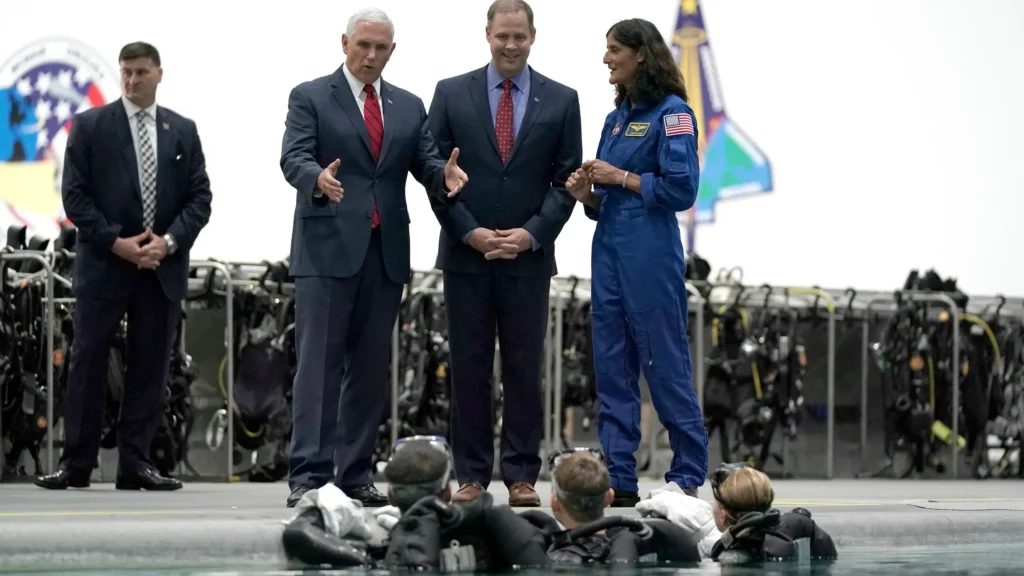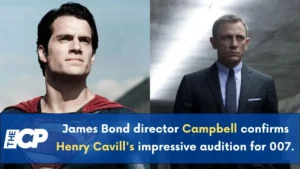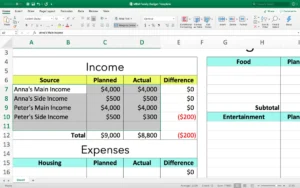In a surprising twist, former President Donald Trump is stepping into the spotlight with a bold plan to bring back two astronauts from the International Space Station (ISS) earlier than expected! NASA is adjusting its schedule to accommodate this unexpected “rescue mission.” Astronauts Suni Williams and Butch Wilmore, who have been living and working in space for nearly 300 days, are about to make headlines as they prepare for their return. Let’s dive into the exciting details of this unfolding space saga and explore why this mission is capturing global attention.
| Attribute | Details |
|---|---|
| Title | Trump’s Political Stunt to ‘Rescue’ ISS Astronauts Is Moving Forward |
| Published Date | February 6, 2025 |
| Astronauts Involved | Suni Williams and Butch Wilmore |
| Spacecraft Used | Boeing CST-100 Starliner and SpaceX Dragon |
| Original Mission Date | June 5, 2024 |
| Planned Return Date | March 19, 2025 |
| Duration in Space | 286 days |
| Reason for Reschedule | Political intervention by President Trump |
| Impact of the Change | Delays subsequent missions to the ISS |
| Current Status | NASA is adjusting their plans to accommodate the return |
Trump’s Last-Minute Space Plans
Recently, President Trump announced a bold plan to bring back astronauts Suni Williams and Butch Wilmore from the International Space Station (ISS) sooner than expected. He claimed that these brave astronauts were “virtually abandoned in space” by the previous administration. This statement seemed to stir up excitement, but in reality, the crew was not in any danger and had been safely conducting their mission aboard the ISS. NASA was already planning their return, highlighting how this political move might have been more about gaining attention than about actual need.
NASA has been working hard to manage the logistics of sending astronauts to and from the ISS. The process involves careful planning and coordination with various spacecraft, like SpaceX’s Dragon vehicles. The decision to bring back the astronauts two weeks early required changes to existing schedules, which could cause delays for other planned missions. While the astronauts were indeed due to return soon, Trump’s intervention raised eyebrows about the necessity of such a political stunt during an already complex space mission.
The Reality of Space Missions
Space missions are intricate operations that require precise timing and planning. NASA typically schedules crewed missions to the ISS months in advance, ensuring that everything from spacecraft readiness to astronaut safety is accounted for. In this case, astronauts Williams and Wilmore were set to return after a long stay in space, which is usually around six months. Their earlier return was more about managing the crew schedule rather than an urgent rescue, showing how space agencies operate methodically rather than reactively.
Astronauts undergo extensive training and are well-prepared for their time in space. The ISS has been home to many astronauts who have successfully managed various challenges while living and working in zero gravity. The notion that they were abandoned or in dire need of rescue misrepresents the realities of space travel. Space agencies prioritize the safety and well-being of their astronauts, ensuring they are not only safe but also supported during their missions.
Understanding Spacecraft Operations
Spacecraft operations involve multiple layers of coordination, from launch to return missions. NASA collaborates with private companies like SpaceX to utilize different vehicles for transporting astronauts. Each spacecraft has specific capabilities and schedules that dictate when they can be used. For example, NASA’s decision to swap spacecraft for the Starliner astronauts demonstrates the flexibility required in space mission planning, as well as the importance of teamwork in the aerospace industry.
The challenges of space travel are numerous, including technical issues and safety protocols. The ISS serves as a critical platform for scientific research, and astronauts contribute to important experiments during their stay. The decision to change the return plan for Williams and Wilmore was not made lightly; it involved consideration of various factors, including spacecraft readiness and the next upcoming missions. This complexity underscores the significance of careful planning in the field of aerospace.
The Implications of NASA’s Schedule Change
NASA’s decision to alter its schedule for the return of astronauts Williams and Wilmore carries significant implications for the agency’s operations. By bringing the astronauts back two weeks earlier, NASA aims to streamline its mission timelines, but this also introduces potential risks. Restructuring launch schedules can affect the overall flow of missions to the ISS, which has a ripple effect on future plans, including the next crewed missions and private partnerships that are crucial for maintaining regular access to space.
Moreover, this schedule change could spark concerns regarding the safety and readiness of the SpaceX Dragon spacecraft. While NASA’s priority is always crew safety, hastening the return of astronauts may lead to rushed preparations that could compromise mission integrity. The long-term repercussions of such impulsive decisions might affect public trust and international partnerships, which are vital for cooperative space exploration efforts.
Political Motivations Behind the Rescue Operation
President Trump’s recent statements regarding the rescue of the Starliner astronauts appear to be rooted more in political theatrics than actual necessity. By framing the astronauts as ‘stranded’ and claiming they need saving, Trump is leveraging the situation to garner public attention and support. This strategic narrative could serve to distract from other pressing political issues, using the astronauts’ mission as a stage for political posturing and populist rhetoric.
Furthermore, this political maneuvering raises questions about the intersection of science and politics. The space sector thrives on bipartisan support and collaborative efforts, yet actions like these may polarize public opinion on NASA’s work. As astronauts Williams and Wilmore are not in any immediate danger, it becomes essential to distinguish between genuine space exploration needs and politically motivated spectacles that might undermine the integrity of scientific endeavors.
The Future of Commercial Space Travel Post-Starliner
The ongoing challenges faced by Boeing’s Starliner program and the recent reshuffle in astronaut return schedules highlight critical lessons for the future of commercial space travel. As NASA collaborates with companies like SpaceX, the reliability of spacecraft is paramount. Delays and technical issues not only impact current missions but also the broader commercial landscape, where public confidence in space travel is at stake. Future programs must prioritize rigorous testing and validation to ensure safe and timely operations.
Additionally, the Starliner situation underscores the importance of a diversified approach in commercial space initiatives. As NASA continues to work with multiple partners, it becomes crucial to maintain a balance between competition and collaboration. The space industry must evolve by learning from these experiences, ensuring that every mission, whether crewed or not, is executed with the utmost safety and reliability, ultimately paving the way for a robust and sustainable future of space exploration.
Public Perception and Media Coverage of Space Missions
The media’s portrayal of the Starliner astronauts’ situation reveals a complex relationship between public perception and space missions. Coverage often sensationalizes events, framing them in a manner that captures attention but may misrepresent the realities of space exploration. In this case, the narrative of astronauts being ‘abandoned’ can lead to misconceptions about the risks and challenges involved in long-duration spaceflight, overshadowing the meticulous planning that underlies every mission.
Moreover, the political undertones in media discussions surrounding the astronauts’ return can influence how the public views NASA and its partnerships with private companies. As the story unfolds, it is essential for both media and agencies to provide clear, factual information to demystify the complexities of space travel. This approach not only enhances public understanding but also fosters a supportive environment for future space initiatives, ensuring that the excitement of exploration is matched by informed engagement.
Frequently Asked Questions
What happened to the astronauts on the International Space Station (ISS)?
The astronauts, Suni Williams and Butch Wilmore, are currently on the ISS and were originally supposed to come back after eight days but will now return earlier due to a schedule change.
Why is President Trump involved with the astronauts’ return?
President Trump wanted to help bring the astronauts back home sooner. He asked SpaceX’s Elon Musk to assist, even though the astronauts were not in danger.
What is the SpaceX Dragon spacecraft?
The SpaceX Dragon is a special spaceship that carries astronauts to and from the ISS. It is important because it helps NASA send and bring back astronauts safely.
How long were the astronauts supposed to stay in space?
The astronauts were supposed to stay for about eight days, but they will now spend around 286 days in space before returning home.
What is Boeing’s CST-100 Starliner?
The CST-100 Starliner is a type of spacecraft made by Boeing that was supposed to take these astronauts to Earth, but it had some problems, so they will now use a SpaceX Dragon instead.
Why did NASA have to change the spacecraft for the astronauts’ return?
NASA had to change the spacecraft because the Starliner had technical issues. They decided it was safer for the astronauts to come back on a SpaceX Dragon.
What does it mean when astronauts are ‘stranded’ in space?
Being ‘stranded’ means being stuck somewhere without a way to get back. In this case, the astronauts were not actually stranded; they were safe but had a longer stay than planned.
Summary
The content discusses NASA’s decision to expedite the return of two astronauts from the International Space Station (ISS) following pressure from President Trump. Initially scheduled for April, the astronauts, Suni Williams and Butch Wilmore, are now set to return on March 19. The change involves swapping a SpaceX Dragon spacecraft due to delays caused by technical issues. Despite the media attention and Trump’s portrayal of the astronauts as “abandoned,” NASA maintains that no rescue was necessary, as the crew was safe and their extended stay was not unusual.








